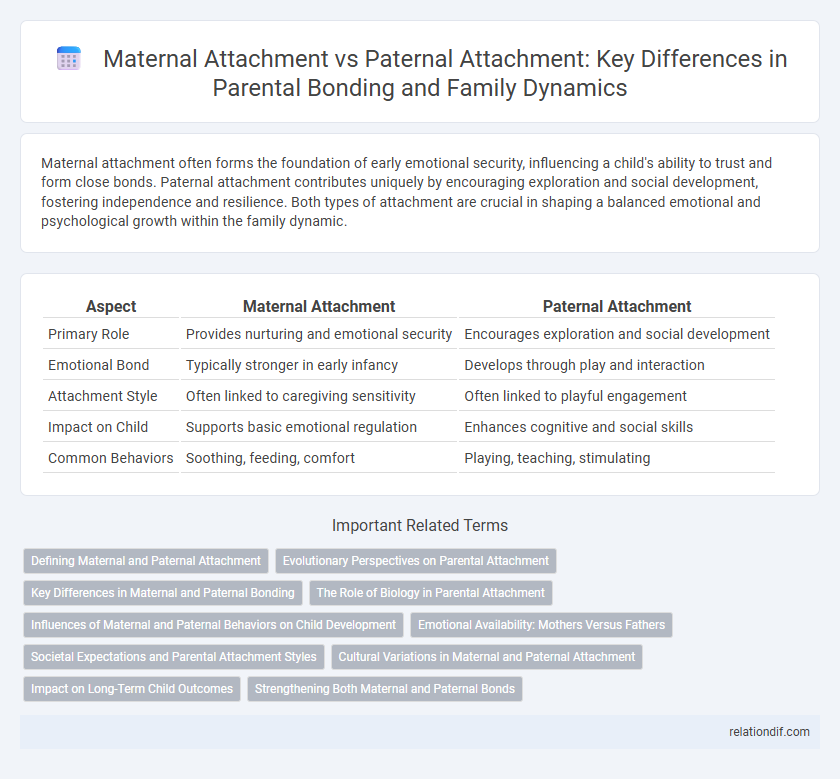Maternal attachment often forms the foundation of early emotional security, influencing a child's ability to trust and form close bonds. Paternal attachment contributes uniquely by encouraging exploration and social development, fostering independence and resilience. Both types of attachment are crucial in shaping a balanced emotional and psychological growth within the family dynamic.
Table of Comparison
| Aspect | Maternal Attachment | Paternal Attachment |
|---|---|---|
| Primary Role | Provides nurturing and emotional security | Encourages exploration and social development |
| Emotional Bond | Typically stronger in early infancy | Develops through play and interaction |
| Attachment Style | Often linked to caregiving sensitivity | Often linked to playful engagement |
| Impact on Child | Supports basic emotional regulation | Enhances cognitive and social skills |
| Common Behaviors | Soothing, feeding, comfort | Playing, teaching, stimulating |
Defining Maternal and Paternal Attachment
Maternal attachment refers to the emotional bond that typically develops between a mother and her child, characterized by nurturing behaviors and primary caregiving roles that promote security and trust. Paternal attachment involves the bond formed between a father and child, often influenced by play, protection, and support functions that complement the maternal role. Both types of attachment are crucial for a child's social, emotional, and cognitive development, with distinct contributions shaping the overall family dynamic.
Evolutionary Perspectives on Parental Attachment
Evolutionary perspectives suggest maternal attachment evolved due to mothers' direct investment in offspring through gestation and nursing, fostering secure bonds crucial for infant survival. Paternal attachment, while less directly linked to physical care, developed to support offspring protection and resource provision, enhancing reproductive success. Neurobiological studies indicate distinct but complementary roles in parental behaviors, shaped by adaptive pressures throughout human evolution.
Key Differences in Maternal and Paternal Bonding
Maternal attachment typically involves nurturing behaviors characterized by emotional warmth, caregiving, and physical closeness, which promote secure infant development and emotional regulation. Paternal attachment often emphasizes playfulness, stimulating interaction, and boundary-setting that contribute to social competence and risk-taking confidence in children. The key differences lie in the distinct roles each parent plays, with mothers fostering safety and comfort, while fathers encourage exploration and autonomy.
The Role of Biology in Parental Attachment
Maternal attachment is heavily influenced by biological factors such as oxytocin release during pregnancy and breastfeeding, which strengthens bonding between mother and child. Paternal attachment, while less directly linked to biology, also involves hormonal changes like increased prolactin and decreased testosterone that promote nurturing behaviors. These biological mechanisms are crucial in shaping early emotional connections and long-term parental involvement.
Influences of Maternal and Paternal Behaviors on Child Development
Maternal attachment often shapes early emotional security by providing consistent nurturing and responsive caregiving, which supports brain development and social competence. Paternal behaviors contribute to cognitive growth and risk-taking skills through playful interaction and encouragement of exploration. Both maternal warmth and paternal engagement are essential for balanced psychological development and adaptive behavior in children.
Emotional Availability: Mothers Versus Fathers
Maternal attachment typically exhibits higher emotional availability, with mothers often providing more consistent sensitivity and responsiveness to infants' emotional needs. Fathers, while increasingly involved in caregiving, may show different patterns of emotional engagement that emphasize play and exploration over nurturing comfort. Research highlights that both maternal and paternal emotional availability uniquely contributes to secure child development by offering complementary forms of support.
Societal Expectations and Parental Attachment Styles
Societal expectations often position maternal attachment as inherently nurturing, fostering secure emotional bonds through consistent caregiving and responsiveness. Paternal attachment styles, influenced by cultural norms emphasizing protection and discipline, may lean toward promoting autonomy while still supporting emotional security. These differing societal roles shape distinct parental attachment behaviors, impacting children's developmental outcomes and interpersonal relationships.
Cultural Variations in Maternal and Paternal Attachment
Cultural variations significantly influence maternal and paternal attachment patterns, with many collectivist societies emphasizing maternal bonding due to traditional caregiving roles, while paternal attachment may be shaped by norms of masculinity and family hierarchy. In Western individualistic cultures, fathers often engage more directly in nurturing, promoting balanced attachment styles between parents. These cultural frameworks affect how attachment behaviors develop, impacting long-term child emotional and social outcomes.
Impact on Long-Term Child Outcomes
Maternal attachment plays a critical role in a child's emotional regulation and social development, often leading to stronger empathy and secure interpersonal relationships in adulthood. Paternal attachment significantly contributes to cognitive development and risk-taking behaviors, influencing academic achievement and resilience. Both maternal and paternal attachments collectively shape long-term psychological well-being, affecting children's mental health and adaptive skills across the lifespan.
Strengthening Both Maternal and Paternal Bonds
Strengthening both maternal and paternal bonds enhances a child's emotional security, cognitive development, and social skills by providing diverse sources of affection and support. Research shows that maternal attachment often fosters nurturing and emotional regulation, while paternal attachment encourages exploration and risk-taking behaviors. Encouraging active, responsive involvement from both parents creates a balanced family dynamic that promotes optimal developmental outcomes.
maternal attachment vs paternal attachment Infographic

 relationdif.com
relationdif.com